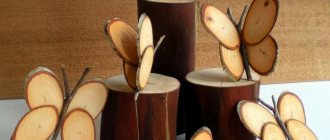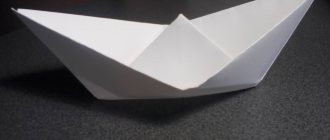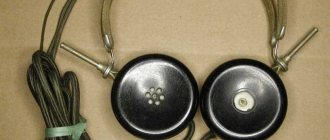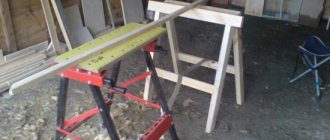Making a paper boat
This trick is familiar to every one of our compatriots whose childhood and youth occurred during the Soviet years. Having reached the present day, a paper boat can push its creator to new, more complex experiments.
In the meantime, it’s worth practicing on paper:
- An A4 sheet is folded in half twice;
- The resulting segment is unfolded once to bend 2 corners towards the center to form a pyramid with a rectangular protrusion;
- The outer side of the protrusion is turned outward so that its corners can be bent into a triangle;
- The inner side of the protrusion is also wrapped, and the corners are bent;
- The resulting triangle needs to be pushed inward to get a flat square;
- Both sides of one half of the square are folded over the other to form an accordion triangle;
- The previous action must be repeated, and then take the ends and unfold the finished ship.
Knowing how to make a ship out of paper, you can move on to more interesting designs.
Making a boat from cardboard
The previous paper model, despite the simplicity of its manufacture, quickly gets wet and loses its ability to float. Also, paper has a lower density compared to cardboard.
Because of this, the latter is more relevant in children's shipbuilding. In addition, cardboard allows you to make a more believable sailboat:
- The lines of the future walls and bottom of the ship are marked on a cardboard sheet (the first should be three - two side ones with a sharp tip and a rear side in the form of a rectangle or square);
- The fragments are cut out and glued to each other using hot glue;
- Inside the structure, you can arrange a two-level “rowing can” for installing a mast.
A toothpick will do as the last one. But how can you make a cardboard ship with a sail so that the design resembles a Viking longship?
First you need to make a cross from two toothpicks. Next, insert a sheet of paper from the bottom of the mast and bring the latter to the horizontal beam.
It is also recommended to complement the mast with a flag, and the nose with a dragon face made of cardboard. But then you will have to attach a tail to the back of the ship for its stability.
Foam liner
Another environmentally flawed project: polystyrene foam cannot be left in the river! The fish are trying to eat it and this diet ends badly for them... But, if your child is responsible and careful, you can ask dad to saw down parts of the ship from unnecessary packaging: the bottom - in the form of an elongated pentagon and the side of the boat - frames of the same shape. By the way, even your mother can handle a small boat; a stationery knife will help you.
The most difficult moment is gluing the layers of foam. Moment glue and other adhesives containing solvents may not be suitable, so use regular PVA glue for crafts that will not be subject to heavy loads, or Styroglue, a special adhesive for ceiling tiles.
“If you applied glue to the parts, pressed them, but they did not stick, it is better to cut out the parts all over again; Dried glue significantly impairs the adhesion strength.
Making a boat from wine corks
A sailboat made from wine corks can be a good alternative to the above designs. To make such a boat, it is enough to have:
- Three plugs;
- Nylon thread;
- Toothpick;
- Colored paper.
Using a gypsy needle, you need to make holes through the plugs so that the latter can be connected to each other with a nylon thread. A toothpick with a sail made of colored paper is stuck into the middle cork and the boat is ready.
Making a boat from a matchbox
This method answers the question of how to make a ship with your own hands so that the design resembles a modern steamship.
To do this, you will also have to arm yourself with cardboard and colored paper:
- First, a frame is made like that of a drakkar;
- The walls and bottom are glued together, and a matchbox is placed inside the boat;
- A small tube is cut out of colored paper to simulate a steam pipe.
Instead of a tube, you can insert a barbecue skewer into the box. If it is located on the bow, then a thread can be drawn from it to the mast. You will need thread to plant flags made of multi-colored paper.
Assembly sequence
Work must be carried out in the following sequence:
- First, we put transverse frames on the keel (longitudinal beam). At the bottom of each of them there is usually a groove for attaching to a plywood keel.
- To join, you can use standard glue, but you can use special adhesive mixtures that are intended for ship modeling.
- We fix the upper parts of the frames on the deck. For simple ship models, the deck consists of one sheet of plywood, while for complex ones it can be multi-level.
- After the glue has dried on the frames, you can begin covering the side with thin strips of plywood. The thickness of the material should not exceed 1.5 mm, since only in this case can you bend the skin without the risk of damaging it.
- To bend veneered plywood, it can be heated and moistened. After this, the material bends easily, and over time takes on a stable shape.
Making a boat from foam plastic
Lightweight ball-shaped material can serve as the basis for the frame. Foam plastic is cut well, which gives the young designer the opportunity to experiment with shapes.
And don’t ask yourself how to make a spaceship? It is enough to find a large piece of foam plastic to cut out the desired design from it, guided by the impressions of watching “Star Wars” or “Starship Troopers”.
The finished spaceship can be launched. And if it exactly repeats the design of the muse, then it belongs on the shelf next to ships in a bottle. By the way, foam plastic can be painted, which is good for young artists.
And a bigger raft...
Great fun for older children is to build an almost real raft from sticks and twigs. The activity is not as simple as it might seem at first glance; In order for the raft to be stable, you must first make a rectangular frame, and then attach the platform sticks to it. Kids can work with sticks the size of their palm, but a group of boys at the dacha of primary school age can easily build a working model that can even withstand the shipbuilders themselves.
“Important: you can test it on people only in a small place and only under adult supervision!
Making a combined boat
After reviewing models made of cardboard, cork, matchbox and foam, it is worth thinking about combining the appropriate materials:
- Cork - suitable for rounded shapes that are inherent in guns;
- Polystyrene foam – relevant for cutting out the side part;
- Matchboxes - well imitate the crew's interior;
- Cardboard is suitable for creating complex figures like sailors.
The appropriate combination serves as an excellent replacement for an expensive construction set.
Having created a ship from improvised materials, a child will not soon ask how to make a ship from Legos so that it resembles a combat one.
In any case, the store design does not stand well on the water, which cannot be said about the thematic analogue.
DIY wooden ship model: from beginning to rainbow horizons
In fact, the history of modeling consists of several stages. Moreover, each of these stages is associated with several characteristics. A miniature shipbuilding enthusiast may need to be able to modify available materials. It is also important to expand the choice of modeling objects. Once it has developed enough, then it can have mass production of models. The next stage will be the development of bench exhibition modeling from the kits that he already has. Subsequently, it can develop to the formation of individual segments. It can be anything - from ship models and in flesh to copies of individual motorcycles, trucks, as well as all sorts of other cars.











